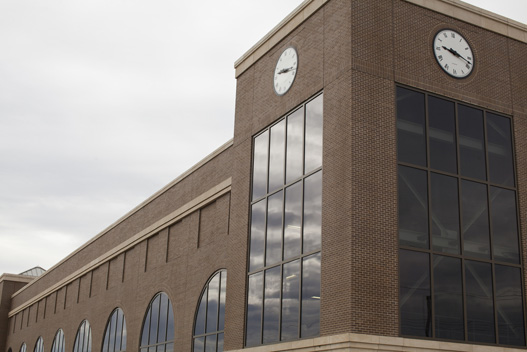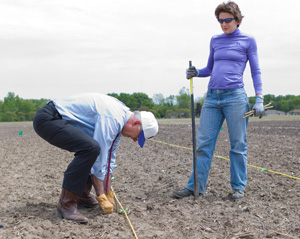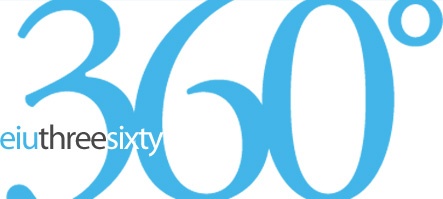
Getting its Renewable Energy Center built and operational was a monumental achievement for Eastern Illinois University and a feather in the cap of its commitment to sustainability.
However, the work required to house such a facility doesn’t end once the final touches are placed on the building itself. Securing and handling the material necessary for a day’s operation of the REC’s gasifiers is also no small task — and that’s where the Department of Biological Sciences is hoping to make its own mark on Eastern’s green efforts.
“It’s taking 110 tons of biomass per day in order to ‘feed the beast’,” said Tom Canam, a second-year member of the biology faculty who is spearheading the department’s biofuel research efforts. He explained that currently, this biomass comes in the form of wood chips shipped to EIU from an outside source.
“Long-term, that might not necessarily be sustainable,” continued Dr. Canam. “We have to think about ways to possibly grow the biomass that needs to go into the giant gasifier facility more locally than we’re getting it now. We have decided to explore different types of crops that could theoretically be used.”
Canam’s presence at EIU was actually brought about by the existence of the REC, explains Biological Sciences chair Karen Gaines.
“Provost Lord and President Perry realized we had an excellent opportunity to not just supply clean energy to campus, but also to build an educational foundation and be educational leaders in that realm,” said Dr. Gaines. “With that, we created different degree programs, but before we did that we needed some faculty members to support the interdisciplinary venture; we had some of the expertise in house, but not enough to fully support what we wanted to do. Through that initiative, Biology received a tenure-track position. So did the School of Technology. Now chemistry is getting a position as well. This was all under the auspices of CENCERE.”
CENCERE, or the Center for Clean Energy Research and Education, was established and organized in order to maximize the educational opportunities presented by the REC. It has resulted, among other things, in a new Master of Science in Sustainable Energy degree program. With an impressive background in biofuel research, Canam was a natural fit.
“He has expertise in chemistry, biochemistry, forestry, and cell and molecular biology. It’s really, really rare to have somebody who can go out in the field and know the aspects of growing biofuels all the way to the cellular and gaseous level.”
So Canam, with heavy involvement from a number of graduate and undergraduate students, has attained permission to use four acres near the REC for growing potential biofuels he believes could represent the right combination of yield and burn properties to make them useful commodities in the new steam plant.
It’s just a matter of figuring out how well these plants — two varieties of hybrid poplar native to the Pacific Northwest, a Japanese grass called Miscanthus, and Illinois-native switchgrass — will grow, burn, and coexist with native flora and fauna. At this point, there are myriad questions left for Canam and his students to answer.
 |
| EIU President William Perry (left) lends a hand planting hybrid poplar trees this spring. Looking on is Karen Gaines, biology department chair. |
“We know those are probably the crops that are going to work,” said Canam. “But in this specific location for this specific application, we don’t really know which will work best. Even with switchgrass, we know we can produce it, but how well will it work with our gasification unit.
"We’ll monitor how it grows, how it’s doing, and ultimately how much yield and total biomass can we get from each acre. Then we’ll have some data to work with.”
It’s an exciting time for the faculty and students in Biological Sciences; bioenergy is a more or less brand new field of study, so everybody is getting a chance to learn through hands-on research.
“In our department, we’re working with so many different aspects of sustainability,” said Gaines. “We’re also extremely engaged in biodiesel as well as tertiary treatment of waste water. So many undergraduate and graduate students are participating in these efforts.”
It’s also a great chance to advance the university’s integrative learning initiatives, since so many academic programs are involved in CENCERE and the many REC-related research efforts.
“That’s the whole purpose of CENCERE, to bring all these departments together,” said Canam. “The educational component of that is to mold students that have a good balance of all these different departments and the perspective each one provides.”
Adds Gaines: “For me, I think it’s wonderful that we’re doing this. A lot of times, universities are far behind on interdisciplinary work; they like their own departments and boundaries. EIU is ahead of the game.”









